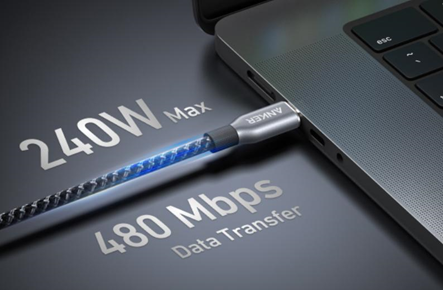The battle between USB-C and Lightning cables often leaves consumers questioning which technology suits their needs. Cables are crucial for charging devices efficiently and quickly. With diverse devices needing different connectors, understanding their differences is key. Whether you’re an Apple enthusiast or an Android supporter, the right cable impacts charging speed and compatibility. This guide explores the basics, comparing USB-C and Lightning on speed, compatibility, and future implications to simplify your choice.

What Are USB-C and Lightning Cables?
Before we dive into performance comparisons, it’s important to understand the origins and fundamental differences between these two connectors.
Origin and Design Differences
USB-C and Lightning come from different origins. Apple launched the Lightning connector in 2012, aimed at simplifying their device connections with a slim, 8-pin reversible design. Meanwhile, USB-C, developed by the USB Implementers Forum, emerged in 2014. It’s marked by a symmetrical, oval shape designed for universality. Unlike Lightning, USB-C integrates with a variety of brands and device types, including laptops, smartphones, and tablets.
How Each Connector Works
Lightning cables use proprietary technology that transfers both data and power efficiently. Despite its efficiency, the design remains exclusive to Apple products. Conversely, USB-C connectors utilize a universal interface supporting higher data rates and power delivery through the USB Power Delivery (USB-PD) specification. This allows rapid charging and seamless integration across diverse platforms, making USB-C a more versatile choice for multipurpose usage.
Charging Speed and Power Delivery Compared
Speed matters when charging your devices—let’s explore which connector delivers more power and faster results.
USB-C Power Delivery Advantages
USB-C cables leverage USB-PD to deliver faster charging speeds up to 100 watts. This allows them to power devices like laptops and monitors, not just smartphones. Moreover, the intelligent power negotiation between devices and chargers optimizes efficiency, reducing charging time significantly. Thus, usb c cable stands out with its remarkable power delivery capabilities and versatility in both home and professional settings.
Limitations of Lightning Charging
While Lightning cables perform commendably in charging efficiency and data transfer, they lack the high-wattage power delivery of USB-C. Typically supporting up to 20 watts in ideal conditions, Lightning is designed predominantly for Apple’s ecosystem. This limits its speed and functionality when compared to the broader capabilities of USB-C, especially for non-Apple products that demand greater power.

Device Compatibility and Ecosystem
A connector’s usefulness is only as strong as the number of devices it supports—here’s how USB-C and Lightning compare in terms of ecosystem reach.
Which Devices Use USB-C
USB-C is embraced by a vast range of manufacturers and devices beyond smartphones. Leading brands incorporate it into laptops, tablets, and more. Its reversible design and robust power capability make it the go-to connector for modern tech, ensuring compatibility for most new gadgets. Whether syncing data or charging, USB-C’s adaptability makes it a favorite across different product lines.
Which Devices Use Lightning
Lightning connectors remain a staple for Apple devices like iPhones, iPads, and certain iPods. Praised for its sleek design and reliability, Lightning offers seamless interaction within Apple’s ecosystem. Despite rumors of a potential shift, Apple’s dedication to its proprietary cable ensures that, for now, users of these products enjoy consistent performance tailored to their specific devices.
Future-Proofing: Which Cable Should You Choose?
With tech evolving rapidly, the cable you choose today should serve you well tomorrow. Let’s assess which one offers better long-term value.
USB-C and the Global Shift
The trend toward USB-C dominance grows with technology’s evolution. As more companies adopt this standard, its universal usage strengthens, leading to simplified connectivity and less e-waste. For most consumers, selecting USB-C-ready devices means better alignment with future innovations in charging and connectivity, showcasing its future-proofing potential.
Why Apple Is Moving to USB-C
Apple’s gradual move towards USB-C signifies a significant shift in its connectivity approach. Factors like harmonizing with international standards and improving user experience drive this change. By aligning more closely with the tech industry’s global direction, Apple aims to enhance compatibility and performance while continuing to innovate its product lineup.
Product Spotlight: Anker USB-C Cables
Anker has established itself as a leader in high-quality USB-C cables, offering durable, fast-charging solutions across a wide range of devices. Known for reinforced construction and intelligent power delivery, Anker cables are built to last while ensuring optimal charging performance. The brand’s dedication to innovation and safety makes it a trustworthy choice for tech-savvy consumers. Whether for smartphones, tablets, or laptops, Anker delivers future-ready reliability that keeps pace with the rapidly evolving demands of modern technology.
Conclusion
Choosing between USB-C and Lightning depends heavily on your device needs and future tech trends. For broader compatibility, faster charging, and alignment with future tech, USB-C leads the way. However, if you are deeply invested in Apple’s ecosystem, Lightning continues to serve effectively. Understanding these distinctions can guide a more informed decision, ensuring optimal performance and compatibility for your technology requirements.